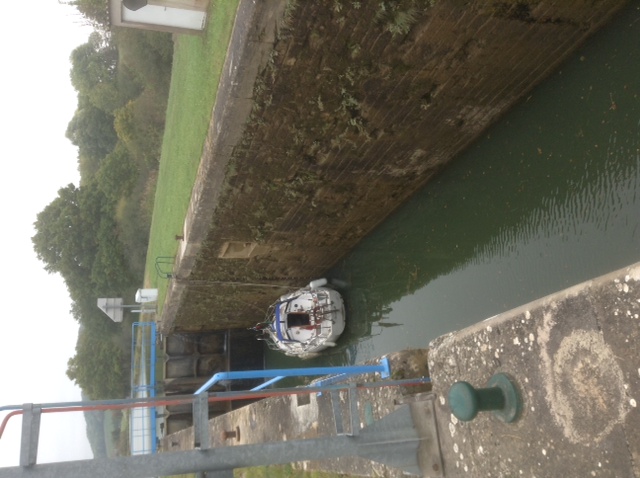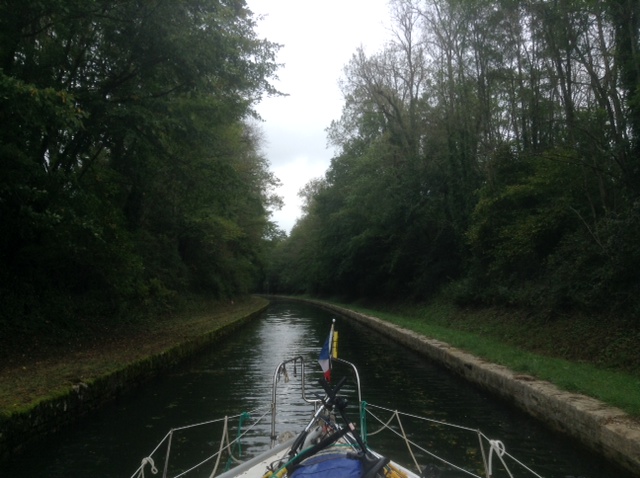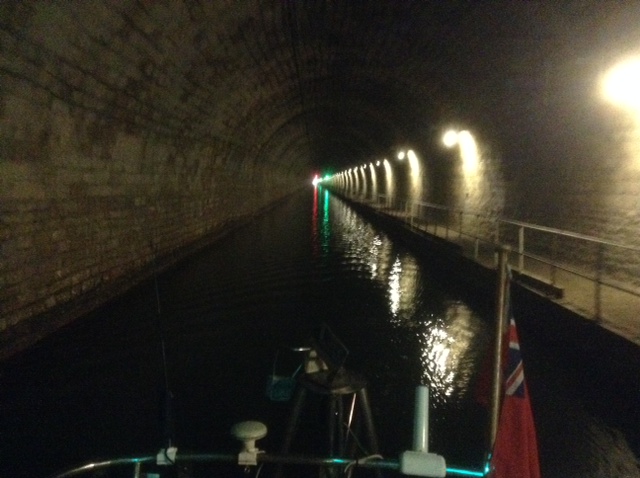Over the top

Beowulf
Tom Fenton and Faith Ressmeyer
Wed 8 Oct 2014 16:19
Yesterday I left the Côte d'Or (which must mean Gold Coast?) without having realised I was in it, and entered the Haute Marne. But the big change, today and a few miles later, was getting over, or through, this range of hills. For the last two and a half days the canal has been lined with Hornbeam, not a tree I see in England much and it took me a while to recognise it. Looks quite like a beech with smaller leaves and with winged seeds, but the wings are asymmetric, so that instead of just descending, they all land up in the canal, and form clumps, and rafts of clumps, and rafts of rafts, until you hardly dare motor through. But they will not wrap around the prop, like the grasses and reeds which they have been cutting on the banks with a flail, and dumping in the water.
This morning I found weed in the engine cooling water inlet filter.
I woke this morning to find the cockpit inches deep in fallen leaves and hornbeam wings. The decks too. I swept the cockpit but not the decks. Standards are falling.
In three hours I did eleven locks and about 6 miles to the mouth of the Balesme Tunnel. Before I tell you about the tunnel, I must show you what happens in the locks. You arrive and the gates are open. You motor in to the ladder which in most cases today was on my right hand side. You slow the boat, grab the ladder, temporarily secure the boat to the ladder (because there is nothing else remotely within reach to secure to) then climb the ladder holding the bow and stern lines one in each hand up a 16 of 17 foot (5.13m) ladder which is covered in canal mud, and loop them round the bollard which ought to be near the top of the ladder. Then things look like this.
Then you cross the lock by the upstream gates, to the control rods on the other side. This is what the view from there looks like. The blue and red rods on the left in the foreground are what you control the lock with.
As soon as you lift the blue rod the locking process starts. The downstream gates start to close, then water enters the lock until the lock is full and you are floating level with the rim. Yes really. The fenders are often well above the rim by the time the upstream gates open.
The big risk in all this is that you will not get the temporary attachment to the ladder off before the lock fills. In theory, if that happens the whole boat will be dragged under and finally sink. Day before yesterday an employee of SNF, who run the canals, assisted me, and at the same time asked me for my plans for the day. This helps them make sure the locks are ready for you. He did not tell me he had activated the locking procedure , while I was checking the guide to tell him where I thought we would get to. I heard groaning. More groaning. When I finally realised what was happening, it was too late, but the rope I had attached was deliberately not too secure in case of such an accident, and it undid itself from my cleat. As a result I lost a good rope which is probably still attached to the ladder. At least I didn't lose the boat.
So you walk smartly back to the boat, crossing the upstream gates again, climb down the ladder, and release the temporary attachment. The automated process gives you just enough time, but there is no margin for distraction, error, or delay, or getting your feet tangled with the ropes you have left dangling over the lock wall, etc. One day, you realise, you will meet a faulty ladder, or slip on a muddy rung, or get your feet twisted in the ropes as you descend. But not today.
So by noon, after eleven locks, I had arrived at the mouth of the Balesmes Tunnel. I stopped to have lunch and prepare the boat. You are expected to have torch, spotlight, two life belts, a fire extinguisher, and so on, at the ready. Then I set off. The Balesmes Tunnel is an extraordinary feat of engineering, as is the whole canal. It is perfectly straight for 4.82 kilometres, say 3miles.
Boats are only allowed through in one direction at a time. However there was no one wanting to go through in either direction so I had it to myself. The approach is a narrow canal, leading to the tunnel entrance, as splendid as something from Chatsworth, but philosophically its complete opposite. Unfortunately the light was simply not good enough to photograph it.
Then you enter the tunnel. You must not do more than 4 km per hour, which is about 2.2 knots I think. I had to guess it, because we don't have a speed counter on our boat, except using gps, and you cannot use gps in a tunnel.
Here is what it looked like for the next hour.
And here is what it looked like looking back.
People said, you can see the exit. Not from 4 kilometres away you can't. Even with binoculars it is unrecognisable.
When you emerge, the world is completely different. First the sun is out. I expected this. Checking the forecasts had persuaded me of the wisdom of getting north of these hills before the violent thunderstorms that are forecast for the Dijon area this weekend. Then it was the trees. No more Hornbeams. It is all sycamore, robbinia, and, for the first time, alder. Then it was the birds. The first birds I saw were a pair of Grey Wagtails, those are the yellowish ones were occasionally see in the UK. Even the cows are different. The Charolais of Burgundy seem to have given way to ... I am not sure what, but I think I saw Aberdeen Anguses a field or two back.
It is warmer, and even though the mooring I planned does not have showers as it promised (thank heavens you readers cannot smell me), and it's electricity apparently only works between 7pm and 8pm, it does have water, and I shall be able to clean the boat.
It feels as if I have crossed a watershed, metaphorically as well as literally. The canal staff have been amazing. The day before yesterday I set off at about 8.45, and the first lock did not seem to recognise my presence. I phoned the control, and explained. He said something rather fast, or too fast for my French. Repettez, s'il vous plait? "A man comes," he said. And sure enough, some 10 minutes later a man came.
Problem was, I had moored between the radar recognition device and the lock. Even though I motored back to the device in the morning, I guess I had not gone far enough back to be distinguished from a downstream vessel.
At several a points a man has shown up, and assisted me with the lock, or not, and asked me my intentions. The last one, last night, asked when I would start in the morning. About nine, I said, is that okay? Sure, he said... well, bien sûr, he said. And explained that he only needed to know because I was in the middle of an automated chain of locks and it was his job to make sure that the next lock in the chain knew I was starting again tomorrow morning.
And he did. I was there at 9.10 and the lock was open and ready for me. They are amazing. But it is hard to believe that the cost of maintaining this system will be affordable for much longer. Everywhere, I have passed more or less recently abandoned commercial uses of the canal. The leisure boats only use the canals in July and August, with a small use in May, June and September. This cannot sustain the level of investment that must be needed to maintain these canals, tunnels and locks.
In short, this is a report from a vanishing world.
Rather like the Grey Wagtail, which, with its cousin the Yellow Wagtail, both of which we have seen in Yorkshire, is now endangered in Britain.
Didn't expect to end on a downer. But now I am descending, "avalant" as they say here, and it would be downhill all the way to Wivenhoe, except that might suggest Wivenhoe is the pits, which is the exact opposite of the truth. So it is downhill all the way in the ascent to Wivenhoe.
PS Where was that soggy plain? The Pays Plaine de Vingeanne, which I have been in for three muddy, damp, dreary days, despite the stunning scenery. And for students of tonic solfa, am I right that in the song I am quoting (The Rain In Spain), the phrase 'I think she's got it' goes soh fa soh te soh?
This is the sort of thing you think about when you don't have company on a voyage like this.




